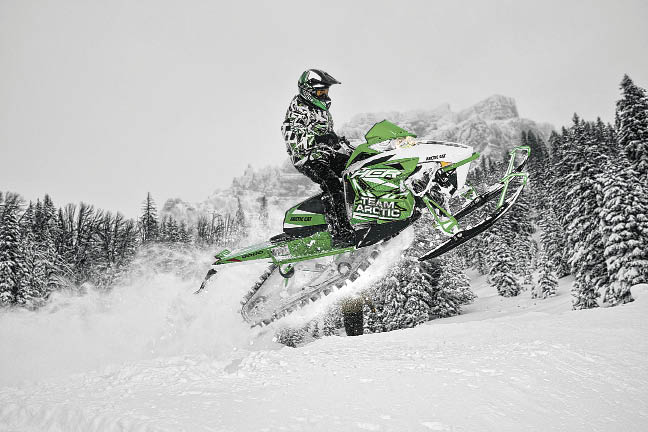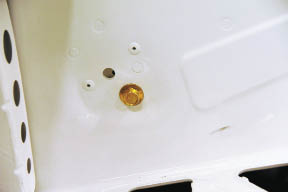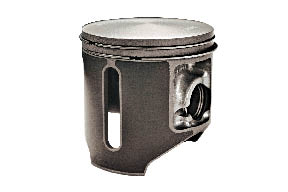.jpeg) We were that close (imagine right here our thumb and index finger very close together). We were right on our hunch that Arctic Cat would unveil a new 600cc engine for model year 2014. However, we were thinking (hoping, actually) that the new made-in-the-U.S.-by-Cat engine would be in a mountain sled. That’s where we missed the mark.
We were that close (imagine right here our thumb and index finger very close together). We were right on our hunch that Arctic Cat would unveil a new 600cc engine for model year 2014. However, we were thinking (hoping, actually) that the new made-in-the-U.S.-by-Cat engine would be in a mountain sled. That’s where we missed the mark.
We’d be lying if we didn’t say we were a little bummed Cat’s new 600cc powerplant isn’t in M skin for this season. But we were quickly distracted when we heard about the weight loss in the 2014 mountain sleds. That’s quite a drop in poundage.
While that weight loss is big news for Arctic Cat, just a little more about the 600 powerplant first. Our hunch was actually somewhat of an educated guess. We remember when Cat dropped the Suzuki 600 from its lineup a couple of years ago (model year 2012), the same season the company unveiled its new ProClimb chassis. We came away from that new snowmobile unveiling with a pretty strong feeling that the 600 hadn’t gone away forever. And it wasn’t too much of a stretch to think Cat could build its own snowmobile engine, as it has been producing ATV engines at its plant in St. Cloud, MN, since February 2007.
And it’s really not going out on a limb to say we’re pretty confident that this 600, officially called the 600 C-Tec2, will be in a mountain chassis next season. We’ll give more details on the Cat 600, but first let’s talk weight loss.
 Handling, Ergonomics
Handling, Ergonomics
Troy Halverson, Cat’s new Mountain Team Manager, said one of the big goals for model year 2014 was “We wanted to work on handling and ergonomics.” So whether the weight loss was part of that equation or simply a byproduct of all the changes, it really doesn’t matter. The end result looks impressive and we’re anxious to ride the new 2014 mountain lineup from Cat.
One area where weight was shaved was by using a new snowmobile seat, which is 5 inches shorter in length and 1.5 inches shorter in height. It features new foam and once again comes with a storage area. The shorter in length part of the seat will make it easier to swing a leg around when you’re jumping from side to side while off-trail riding. The new seat comes on all M8000 (Cat has a new designation for its models--the 8000 is an 800cc sled) Sno Pro, Limited (non-ES) and HCR models.
Other weight savings come in little areas like drilling out the brake disc (Sno Pro, Limited models only), lightening up the drive shaft and drive sprockets, changing the bottom gear to aluminum (Sno Pro, Limited models only), changing the hardware on the shocks by reducing the size of the hardware, drilling some parts to make them lighter while maintaining their strength, and replacing the rear heat exchanger on the M models to the one presently used on the HCR (Sno Pro, Limited models only). The heat exchanger swap saves 4 lbs. alone and is a single, front-mounted unit only. To ensure the cooling capacity of the sled is still maintained, Cat has installed a coolant tank on those sleds with the HCR-type heat exchanger. Models with the HCR-style exchanger come standard with ice scratchers.
Cat shaved nearly a pound by using lighter weight ski spindles, which are a one-piece forged unit.
Additionally, the down spars and cross spars on the Sno Pro and Limited model chassis are now aluminum (as opposed to steel) and the spindles are machined out. All 2014 M8000 models get the aluminum chassis spars.
“Ounces add up to pounds,” Halverson pointed out.
While all those changes were made to save weight and, in some cases, improve the ergonomics and handling as well, there are even more changes on the 2014 Cat mountain machines. This one is subtle but will be appreciated by aggressive riders. At the rear of the tunnel where the running board attaches, Cat has machined the rear tunnel gusset to open it up so the rider can put his foot farther back on the running board.

 Putting On The Brakes
Putting On The Brakes
Another change is to the brake guard at the front on the tunnel on the left side of the sled in the footwell. Halverson said some riders were denting the guard when they were trying to kick snow out of the front of the running board on that side so Cat made it stronger to prevent that from happening.
Cat also changed the gearing on the M sleds from 21/49 to 19/50, which should help in a number of ways, most notably improving the performance of the sled in certain conditions. Halverson pointed out that Cat is changing clutch performance for next season so that the sleds will backshift better and offer a little more consistent rpm, all while helping keep the belt temps a little cooler.
While on the subject clutching, Cat has redesigned the driven clutch so that the fin height on the face of the clutch is deeper, which helps it run cooler by dissipating the heat better. Cat also went to a fixed clutch guard so that it’s easier for the rider (or whomever) to get to the clutches and change the belt.

Hang on, there’s more. The skid frame has been moved down and back; Halverson pointed out that the company “has seen better results with less trenching.” The ski shocks are new, having been replaced by Fox Float 3 shocks (they were Fox Float 2 shocks), which offer easier access to the air valve. Additionally, the Fox Float 3 uses “negative” spring technology to deliver a more plush ride during initial travel and faster, stiffer cornering while maintaining big-hit control. The front arm shock is now an Arctic Cat shock (vs. the Fox Zero Pro on some ‘13 models). Why the change to the Arctic IFP rebuildable gas shock? Halverson said it allows Cat more flexibility to change calibrations and make those changes quicker with less lead time.
Up on the handlebars, the piston in the master brake cylinder is smaller for 2014. That means it will take less force at the lever to get the same amount of force at the brake. The disc goes from 5/8-inch to 9/16-inch. The dual piston caliper is mounted on the rear portion of the rotor so that any chassis flex won’t knock back the pistons.
New Classifications
Another fairly noticeable change for 2014 is the change in name or classification on the models themselves. Here’s the Cat lineup for 2014:
• M 8000 153 (Suzuki 794cc twin)
• M 9000 153 (Suzuki 1056cc four-stroke turbo)
• M 8000 153 Sno Pro (Suzuki 794cc twin)
• M 8000 153 Limited (Suzuki 794cc twin)
• M 8000 153 Limited ES (Suzuki 794cc twin w/electric start)
• M 8000 162 Sno Pro (Suzuki 794cc twin)
• M 8000 162 Limited (Suzuki 794cc twin)
• M 8000 162 Limited ES (Suzuki 794cc twin w/electric start)
• M 8000 153 HCR (Suzuki 794cc twin)
• M 9000 162 HCR (Suzuki 1056cc four-stroke turbo)
• M 9000 162 Sno Pro (Suzuki 1056cc four-stroke turbo)
• M 9000 162 Limited (Suzuki 1056cc four-stroke turbo)
As you can see, basically there are the 800cc and 1100cc turbo powerplants.
Now to the new Arctic Cat C-Tec2 600, which fits in the 125 hp class. We really just don’t have the room to talk about all the features of this new engine so we’re going to just hit the highlights. For starters the engine features a very unique dual-stage injection system which utilizes a slotted piston. At lower engine loads, the system injects fuel directly into the combustion chamber on top of the piston. At higher engine loads fuel is also injected into the crankcase area and into the transfer ports, improving the fuel/air transfer time for added efficiency while also lubricating vital engine components.
As for the slotted piston, a unique open-window/slotted design allows the fuel/oil mix to be injected into the crankcase area and then into the transfer ports as part of the dual-stage injection design. Essentially, the slotted piston increases the time the fuel/oil mix can be injected.
The oil is mixed with the fuel in the injector rail so it can lubricate and cool vital parts such as the rod pin bearing and other key engine components.
In comparing the new Arctic Cat C-Tec 2 600 with the old Suzuki 600 EFI (“It’s night and day different than our old 600,” Cat engine guru Greg Spaulding said), the new engine is 10 lbs. lighter than the old 600 and has more horsepower (123 vs. 118). The mpg is “greatly improved” in the new Cat 600 and it’s cleaner, Spaulding said. “We achieved our emission goals and this engine generates credits,” he said. In fact, Cat claims the C-Tec 2 has lower CO emissions and is lighter weight than Ski-Doo’s 600 E-Tec engine.
It’s recommended sledders use 91 octane non-ethanol fuel for maximum performance of the new Cat 600. If 91 non-ethanol is not available, the fuel management system along with the knock sensor is able to sense detonation in the cylinder head and make the necessary adjustments. That will reduce performance and mpg, which is why the higher octane is recommended.
Other really interesting engine news from Arctic Cat for model year 2014 is the use of Yamaha’s 1049cc 4-stroke engine in Cat’s 7000 sleds (135 hp). Cat has signed an agreement to purchase the 3-cylinder engine from Yamaha but will be using its own fuel management system. Also, the exhaust/muffler has been designed to exit in the rear of the engine and turns to the traditional right side of the snowmobile. The engine will be used in select Cat trail machines, not its mountain sleds. As noted above, Cat will continue to use a Suzuki 4-stroke for its mountain machines.